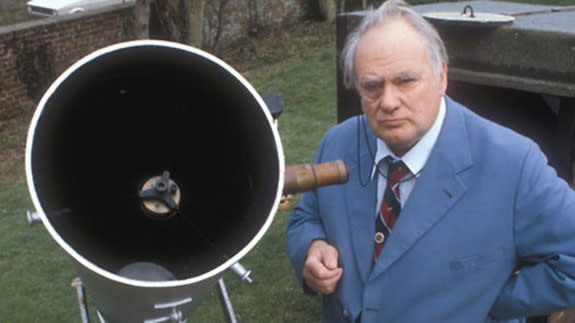 Science and Weather
Science and WeatherBritish astronomer Patrick Moore dies at age 89

Sir Patrick Alfred Caldwell-Moore, known publicly as Patrick Moore, astronomer and 55-year host of the BBC astronomy series The Sky at Night, passed away in his home on Sunday, at the age of 89.
An enthusiastic astronomer since the age of six, Moore was running a small observatory by age 14. After serving in World War II, he wrote his first astronomy book - titled Guide to the Moon - in 1952, and would go on to write or co-write over 300 books (counting multiple editions and languages pushes that number up over 1000), according to Astronomy Now. At the age of 31, after participating in a 1950 televised debate opposite several proponents of UFO sightings, including former RAF Air Chief Marshal Hugh Dowding, he was offered the chance to host his own astronomy show. The Sky at Night first aired on April 26, 1957, and in the over 55 years since then, he has only missed one episode (July 2004), due to suffering through a near-fatal case of food poisoning. With a total of 705 episodes, and him hosting 704 of those, the Guinness Book of World Records lists The Sky at Night as the 'Longest Running TV Show with the Same Presenter', and Moore as the 'Most Durable TV Presenter'.
Despite some rather 'colourful' political and social opinions — including his support of the Official Monster Raving Loony Party — Moore was beloved by the British people. He was generous to a fault, especially to young astronomers, several of whom he supported through gifts of equipment and sponsorship through university. Also, perhaps in typical British fashion, Moore employed satire and wit to poke fun at various groups, penning the book Bureaucrats: How to Annoy Them under a pseudonym, and (apparently) anonymously co-writing A Flying Saucer from Mars which was a parody of the UFO phenomenon.
[ More Geekquinox: December's Geminid meteor shower may originate from 'rock comet' ]
Also, although he only referred to himself as an 'amateur' astronomer, he made several important contributions to the science.
He made extensive observations and maps of the Moon, and was particularly interested in its far side. Although the Moon is 'tidally-locked' to Earth, so we only see one side of it, since the Moon's orbit is both elliptical and at a slight angle relative to the Earth's equator, the Moon seems to oscillate. This is called lunar libration, and because of this, we can see the edges of the far side (a little under 10 per cent of its surface area). Due to his dedication to lunar observation, Moore was granted permission by the Russians to air pictures from their Luna 3 probe on his show.
In 1995 he published the Caldwell Catalogue, a list of 109 astronomical objects visible in the night sky, to address issues of missing objects and a bias towards the northern hemisphere he saw in the popular Messier Catalgue. Also, unlike the Messier Catalogue, which lists objects in the order they were discovered, Moore organized the objects in his catalogue from northernmost to southernmost. The Caldwell Catalogue is now one of three references, along with the Messier Catalogue and the Herschel 400 Catalogue, used extensively by backyard astronomers in their viewing of the night sky.
[ More Geekquinox: Earthquake in Japan could be an aftershock of March 2011 temblor ]
Moore had received numerous honours in his lifetime, including being made an officer of the Order of the British Empire, becoming the honorary president of the East Sussex Astronomical Society, being knighted for 'services to the popularization of science and to broadcasting', and becoming the only amateur astronomer ever appointed as an Honourary Fellow of the Royal Society, which, according to his close friend, Queen guitarist and astrophysicist Brian May, was the honour he was most proud of.
After such a life and such accomplishments Moore will be sorely missed.


